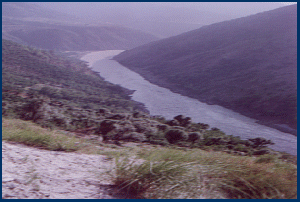Chenab: Difference between revisions
mNo edit summary |
mNo edit summary |
||
| Line 6: | Line 6: | ||
The river then travels to Reasi,where it has been dammed at Salal at Hydroelectric Project. | The river then travels to Reasi,where it has been dammed at Salal at Hydroelectric Project. | ||
There is a motorable road runs along the river in the stretch between Atholi, Malhori, Perah and Ramban, Kautham and Jourian in J&K. The road is often 50 to 100 meters above the river Chenab with wonderful view of various facets of the river. | |||
The river was known to Indians in Vedic period as Ashkini (Sanskrit: अशढ़किनि) or Iskmati and as Acesines to the Ancient Greeks. In 325 BC, Alexander the Great allegedly founded the town of Alexandria on Indus (present day Uch Sharif or Mithankot or Chacharan) at the confluence of the Indus and the combined stream of [[Punjab]] rivers (currently known as the Panjnad River). | The river was known to Indians in Vedic period as Ashkini (Sanskrit: अशढ़किनि) or Iskmati and as Acesines to the Ancient Greeks. In 325 BC, Alexander the Great allegedly founded the town of Alexandria on Indus (present day Uch Sharif or Mithankot or Chacharan) at the confluence of the Indus and the combined stream of [[Punjab]] rivers (currently known as the Panjnad River). | ||
Latest revision as of 03:57, 12 October 2007
The Chenab River (Punjabi: ਚਨਾਬ, Hindi: चनाब, literally: 'Moon(Chen) River(ab)') is formed by the confluence of the Chandra and Bhaga rivers at Tandi located in the upper Himalayas, in the Lahul and Spiti District of Himachal Pradesh, India. In its upper reaches it is also known as the Chandrabhaga. It flows through the Jammu region of Jammu and Kashmir into the plains of the Punjab, forming the boundary between the Rechna and Jech interfluves (Doabs in Persian). It is joined by the Jhelum River at Trimmu, and then by the Ravi River. It then merges with the Sutlej River near Uch Sharif to form the Panjnad ('Five Rivers'), which joins the Indus at Mithankot. The total length of the Chenab is approximately 960 kilometres. The waters of the Chenab are allocated to Pakistan under the terms of the Indus Waters Treaty.
The Chenab originates from the Bara Lacha Pass in Himachal Pradesh,has been considered as the source of the glacier fed perennial river.The anicient knew the river ar ASIKNI,it has two sources one which flows down south known as Chandra and that goes to North named as Bhaga. About 26 Km further south from Manali (a tourist place in Himachal Pradesh) ,a motorable road runs along the river,from Khoskhas to Tandi. In all 107 Km length of road run side by side of river during the sarjoun of Himachal Pardesh.The Chandra and Bhaga meets to form Chandrbhaga at Tandi. It becomes Chenab when it joins Marau at Bhandera Kot 12 Km from Kishtwar Town in J&K.
The river then travels to Reasi,where it has been dammed at Salal at Hydroelectric Project. There is a motorable road runs along the river in the stretch between Atholi, Malhori, Perah and Ramban, Kautham and Jourian in J&K. The road is often 50 to 100 meters above the river Chenab with wonderful view of various facets of the river.
The river was known to Indians in Vedic period as Ashkini (Sanskrit: अशढ़किनि) or Iskmati and as Acesines to the Ancient Greeks. In 325 BC, Alexander the Great allegedly founded the town of Alexandria on Indus (present day Uch Sharif or Mithankot or Chacharan) at the confluence of the Indus and the combined stream of Punjab rivers (currently known as the Panjnad River).
The Chenab has the same place in the consciousness of the people of the Punjab, as, say the Rhine holds for the Germans, or the Danube for the Austrians and the Hungarians. It is the iconic river around which Punjabi consciousness revolves, and plays a prominent part in the tale of Heer Ranjha, the Punjabi national epic.
| Rivers of Punjab and beyond |
|
Beas -|- Satluj -|- Ravi -|- Chenab -|- Jhelum -|- Ghagger -|- Sirsa -|- Ganges -|- Yamuna |

